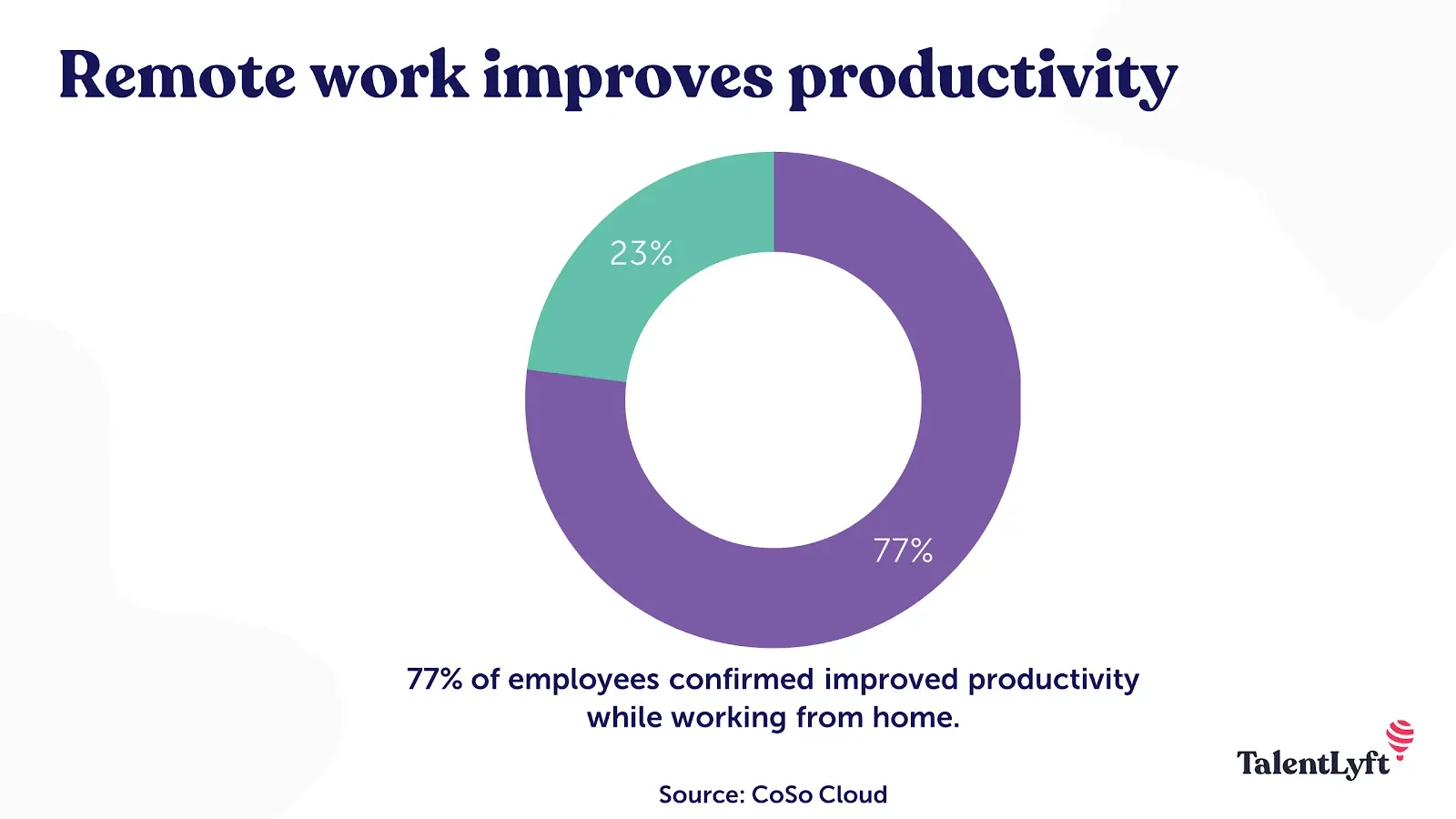The impact of remote work on productivity has been a hot topic of discussion, capturing the attention of businesses and employees alike. As more companies embrace flexible work arrangements, understanding how these changes affect work from home productivity is crucial. Research has shown that telecommuting can lead to increased efficiency, yet it also presents unique challenges in remote team management. The benefits of remote work are numerous, from decreased commute times to a better work-life balance, but finding the right strategies to maintain output is essential. Ultimately, the evolving landscape of work calls for a closer look at how these shifts influence overall productivity.
Exploring the effects of working away from a traditional office environment reveals significant trends in employee performance. Telework, often linked to greater autonomy, can enhance individual motivation and lead to a more satisfied workforce. Meanwhile, the dynamics of team collaboration change in this remote setup, prompting new strategies in managing dispersed groups. The rise in telecommuting highlights the necessity for companies to adapt their policies to foster an effective and productive virtual workspace. By leveraging the advantages of this modern workforce model, organizations can unlock unprecedented levels of creativity and efficiency.
The Rise of Remote Work in Today’s Economy
Remote work has become a prevailing trend in today’s business environment. The COVID-19 pandemic accelerated this shift, pushing companies toward telecommuting arrangements to maintain operations. This transformation has opened doors for organizations to tap into a wider talent pool, allowing them to hire skilled professionals from different geographical areas without the constraints of traditional office settings.
Many companies are now recognizing the value of flexible work arrangements as a method to enhance employee satisfaction and retention. Research shows that organizations embracing remote work can adapt better to changes in the market, offering them a competitive edge. Furthermore, businesses can greatly reduce overhead costs associated with physical office spaces.
Impact of Remote Work on Productivity
The impact of remote work on productivity has been a subject of extensive debate among researchers and business leaders. While some studies indicate a noticeable increase in productivity levels when employees work from home, others suggest challenges related to communication and collaboration. The ability to create a personalized working environment contributes positively, allowing individuals to minimize distractions and manage their schedules effectively.
Moreover, telecommuting effects on employee emotional well-being should not be overlooked. Many remote workers report improved work-life balance and reduced stress, which can lead to enhanced efficiency. However, effective remote team management practices, such as regular check-ins and fostering a culture of accountability, are essential to gain the full benefits of remote work scenarios.
Benefits of Remote Work for Employees
Remote work offers numerous advantages for employees, such as flexibility in choosing work hours and the elimination of commute times. Such benefits enable individuals to allocate more time for personal pursuits or family commitments, directly contributing to their job satisfaction and overall well-being.
Additionally, the savings on transportation costs and the ability to work from anywhere provide financial and emotional relief to employees. Flexible work arrangements encourage a healthier lifestyle, reducing the stress associated with traditional office pressures. Overall, the well-being of remote workers is significantly enhanced by the autonomy they experience in their daily routines.
Challenges of Telecommuting
Despite its numerous benefits, remote work poses several challenges that organizations must address. Communication breakdowns can occur when team members are not physically present, leading to misunderstandings and reduced collaboration. Maintaining a strong company culture can also be difficult when employees work in isolation.
Furthermore, some individuals may struggle with motivation and discipline in a home environment, making it crucial for leaders to enforce clear expectations and provide the necessary tools for success. Implementing regular virtual meetings, encouraging social interactions among team members, and creating an engaging virtual workspace can mitigate these challenges.
Strategies for Effective Remote Team Management
For remote teams to function effectively, managers must adapt their leadership styles to accommodate flexible work arrangements. This includes establishing clear communication channels, setting specific goals, and utilizing productivity tools that support collaboration and accountability among team members.
Additionally, establishing a robust onboarding process for new employees within a remote framework is essential. Regular feedback and support can foster a sense of belonging and help remote workers feel valued and connected to their organization, which ultimately enhances team morale and productivity.
Technology’s Role in Remote Work Success
The success of remote work heavily relies on technology, which facilitates communication and collaboration across different locations. Cloud-based tools, project management software, and video conferencing platforms have become essential for teams to stay connected and synchronized in their tasks.
Moreover, investing in cybersecurity measures is crucial for protecting sensitive information shared over digital platforms. As companies shift to remote work, ensuring that employees have access to secure and reliable technology not only boosts productivity but also instills confidence in remote operations.
The Future of Work: A Hybrid Model
As organizations have navigated the transition to remote work, many are now considering a hybrid model as a sustainable long-term approach. This model combines the benefits of remote work with in-office collaboration, allowing employees to choose where they work based on their personal needs and team requirements.
The hybrid work model promotes flexibility while still encouraging in-person interactions that can bolster creativity and teamwork. Companies that successfully implement a mixed approach may find themselves better positioned to adapt to future challenges while supporting a diverse workforce.
Promoting Employee Well-Being in Remote Environments
To foster a productive remote work environment, companies should prioritize employee well-being. This can include offering mental health resources, flexible schedules, and the ability for employees to disconnect from work. Ensuring that employees have a proper work-life balance contributes to their effectiveness and satisfaction.
Furthermore, organizing virtual team-building events and social gatherings can create connections among remote workers, helping them feel more integrated into the company culture. When employees feel valued and supported, they are more likely to excel in their roles and contribute positively to the organization.
Evaluating Job Performance in a Remote Setting
Evaluating job performance in a remote work environment requires a shift in traditional approaches. Instead of focusing solely on time spent working, managers should measure employees based on outcomes and deliverables. Establishing clear metrics and goals can help ensure that remote workers remain accountable for their performance.
Additionally, fostering an open feedback culture where employees can discuss their challenges and successes allows for continuous improvement. This approach not only increases accountability but also empowers employees to take ownership of their roles and strive for excellence.
Frequently Asked Questions
What is the impact of remote work on productivity levels?
The impact of remote work on productivity can vary, but many studies find that employees often experience increased productivity when telecommuting. This boost is typically attributed to fewer distractions, less time commuting, and a more comfortable working environment.
How do remote work benefits influence overall work from home productivity?
Remote work benefits, such as flexible hours and the ability to create a personalized workspace, significantly enhance work from home productivity. These advantages allow employees to manage their time more effectively and adapt their work environment to suit their needs.
What are the telecommuting effects on employee engagement and productivity?
Telecommuting effects on employee engagement include higher job satisfaction and motivation, which can lead to improved productivity. Employees often feel more trusted and valued, resulting in increased output and quality of work.
How can effective remote team management improve work from home productivity?
Effective remote team management is crucial in improving work from home productivity. By implementing clear communication strategies, setting defined goals, and utilizing technological tools for collaboration, managers can foster a more productive remote work environment.
What role do flexible work arrangements play in enhancing remote work productivity?
Flexible work arrangements play a significant role in enhancing remote work productivity by allowing employees to work at their peak performance times. This flexibility helps reduce burnout and increases overall job satisfaction, which contributes to higher productivity levels.
Can remote work impact long-term productivity for a business?
Indeed, remote work can positively impact long-term productivity for a business. By adopting remote work policies, companies can benefit from a wider talent pool, lower overhead costs, and higher employee retention rates, all of which contribute to sustained productivity growth.
What strategies can companies implement to maximize productivity in remote teams?
Companies can maximize productivity in remote teams by encouraging regular check-ins, providing proper training and resources, promoting a healthy work-life balance, and using project management tools to streamline tasks and communication.
How does the work from home productivity differ across various industries?
Work from home productivity can differ across industries due to the nature of tasks performed. For instance, tech and creative industries often report higher productivity levels, while sectors requiring direct customer interaction may face challenges that impact remote efficiency.
What are the best practices for maintaining productivity in remote work environments?
Best practices for maintaining productivity in remote work environments include establishing a designated workspace, setting a consistent routine, using productivity tools for task management, and prioritizing regular breaks to avoid fatigue.
How can employee feedback on remote work benefits influence productivity outcomes?
Employee feedback on remote work benefits can greatly influence productivity outcomes by allowing organizations to refine their telecommuting policies. Understanding employee needs helps tailor flexible work arrangements that foster higher engagement and productivity.
| Key Point | Explanation |
|---|---|
| Flexibility | Remote work offers employees greater flexibility in managing their work hours and personal responsibilities. |
| Increased Productivity | Many employees report higher productivity levels while working remotely due to fewer distractions. |
| Work-Life Balance | Remote work has improved work-life balance for many, reducing commute times and allowing for more personal time. |
| Collaboration Challenges | Some teams face difficulties collaborating effectively due to the lack of face-to-face interaction. |
| Technology Dependence | Remote work relies heavily on technology, leading to both benefits and potential issues if tools fail. |
Summary
The impact of remote work on productivity is significant and multifaceted. While many employees enjoy enhanced flexibility and report increased productivity due to fewer distractions and better work-life balance, challenges such as collaboration difficulties and dependence on technology can arise. Overall, remote work has transformed the way we approach our jobs, leading to a shift in traditional workplace dynamics.



